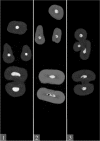Comparison of three different biomaterials used in in vitro molar apexification models
- PMID: 37391750
- PMCID: PMC10311754
- DOI: 10.1186/s12903-023-03180-y
Comparison of three different biomaterials used in in vitro molar apexification models
Abstract
Objectives: New biomaterials had some advantages such as mixing and easier application as compared to traditional MTA in single step apexification method. This study aimed to compare the three biomaterials used in the apexification treatment of immature molar teeth in terms of the time spent, the quality of the canal filling and the number of x-rays taken to complete the process.
Methods: The root canals of the extracted thirty molar teeth were shaped with rotary tools. To obtain the apexification model, ProTaper F3 was used retrograde. The teeth were randomly assigned into three groups based on the material used to seal the apex; Group 1: Pro Root MTA, Group 2: MTA Flow, Group 3: Biodentine. The amounts of the filling, the number of radiographs taken until treatment completion and the treatment duration were recorded. Then teeth were fixed for micro computed tomography imaging for quality evaluation of canal filling.
Results: Biodentine was superior to the other filling materials according to time. MTA Flow provided greater filling volume than the other filling materials in the rank comparison for the mesiobuccal canals. MTA Flow had greater filling volume than ProRoot MTA in the palatinal/distal canals(p = 0.039). Biodentine had greater filling volume more than MTA Flow in the mesiolingual/distobuccal canals (p = 0.049).
Conclusions: MTA Flow was found as a suitable biomaterial according to the treatment time and quality of root canal fillings.
Keywords: Apexification; Biodentine; MTA; MTA Flow; Multi-rooted teeth.
© 2023. The Author(s).
Conflict of interest statement
All authors declare no conflict of interest.
Figures
Similar articles
-
Comparative evaluation of four endodontic biomaterials and calcium hydroxide regarding their effect on fracture resistance of simulated immature teeth.Eur J Paediatr Dent. 2020 Mar;21(1):23-28. doi: 10.23804/ejpd.2020.21.01.05. Eur J Paediatr Dent. 2020. PMID: 32183524
-
Effect of apexification on occlusal resistance of immature teeth.BMC Oral Health. 2020 Nov 12;20(1):325. doi: 10.1186/s12903-020-01317-x. BMC Oral Health. 2020. PMID: 33183284 Free PMC article.
-
Micro-CT evaluation of voids using two root filling techniques in the placement of MTA in mesial root canals of Vertucci type II configuration.Clin Oral Investig. 2018 Jun;22(5):1907-1913. doi: 10.1007/s00784-017-2282-0. Epub 2017 Nov 25. Clin Oral Investig. 2018. PMID: 29177813
-
Apical Closure in Apexification: A Review and Case Report of Apexification Treatment of an Immature Permanent Tooth with Biodentine.J Endod. 2016 May;42(5):730-4. doi: 10.1016/j.joen.2016.02.007. Epub 2016 Mar 16. J Endod. 2016. PMID: 26994597 Review.
-
Mineral trioxide aggregate and other bioactive endodontic cements: an updated overview - part II: other clinical applications and complications.Int Endod J. 2018 Mar;51(3):284-317. doi: 10.1111/iej.12843. Epub 2017 Oct 11. Int Endod J. 2018. PMID: 28846134 Review.
Cited by
-
Evaluation of Microleakage of Orthograde Root-Filling Materials in Immature Permanent Teeth: An In Vitro Study.Int J Biomater. 2024 Oct 29;2024:8867854. doi: 10.1155/2024/8867854. eCollection 2024. Int J Biomater. 2024. PMID: 39502809 Free PMC article.
References
-
- Escribano-Escriva B, Mico-Munoz P, Manzano-Saiz A, Giner-Lluesma T, Collado-Castellanos N, Muwaquet-Rodriguez S. MTA apical barrier: In vitro study of the use of ultrasonic vibration. J Clin Exp Dent [Internet]. 2016;0–0. Available from: http://www.medicinaoral.com/medoralfree01/aop/53085.pdf. - PMC - PubMed
-
- Alhaddad Alhamoui F, Steffen H, Splieth C. The sealing ability of ProRoot MTA when placed as an apical barrier using three different techniques: an in-vitro apexification model. Quintessence Int. 2014;45(10):821–827. - PubMed
Publication types
MeSH terms
Substances
LinkOut - more resources
Full Text Sources
Miscellaneous


